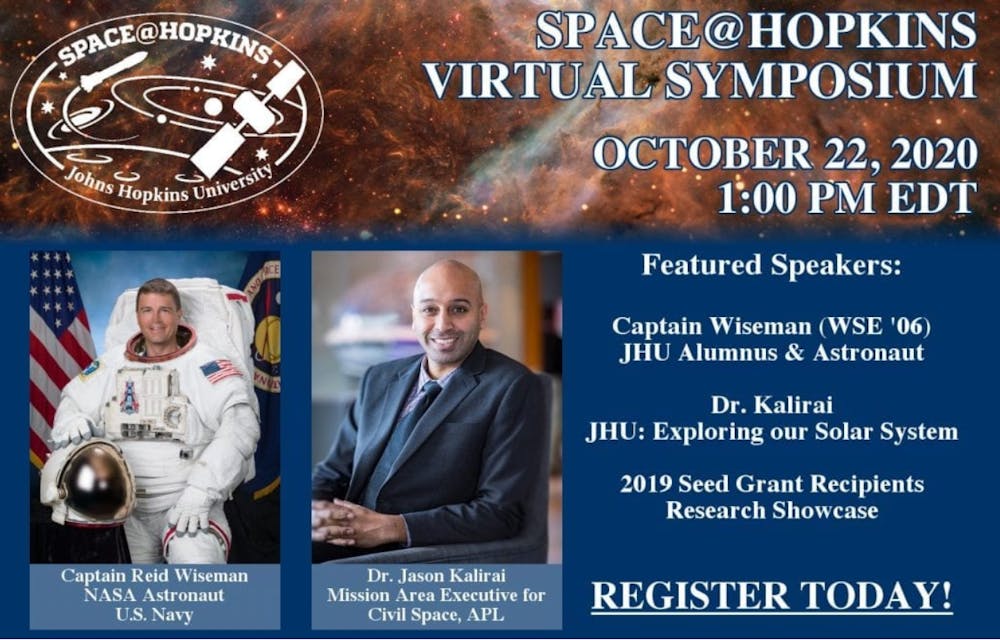The Space@Hopkins Virtual Symposium held on Oct. 22 explored the successes and future goals of space research across divisions of the University. The event featured talks over Zoom with Jason Kalirai, a mission area executive for civil space of the Hopkins Applied Physics Laboratory (APL); Captain Reid Wiseman, an astronaut and Hopkins alum; and Hopkins researchers who received 2019 Seed Grant Awards.
In his talk, Kalirai explained how the APL has focused its programs on planetary science and heliophysics, which seeks to understand how the sun interacts with the solar system.
One such program launched the New Horizons interplanetary space probe that traveled four billion miles to fly by and characterize Pluto. The probe launched in 2006 and performed the flyby nine years later in 2015, finding evidence of volcanic deposits and water ice.
Kalirai also mentioned the Van Allen Probes mission. Formerly known as the Radiation Belt Storm Probes, the mission involved two spacecraft that flew through the Earth’s radiation belts and allowed scientists to study the high-energy particles found there.
Several missions, Kailrai noted, including the launch of the Parker Solar Probe in 2018, which aims to study the outer corona of the sun, used novel methods of traveling to the sun.
“One of the big innovations was a brand new way of envisioning this mission in which we could leverage multiple flybys of the planet Venus to drop the orbit of the spacecraft closer to the sun as it went through its mission,” he said.
APL was selected to lead the next program pertaining to heliophysics called the Interstellar Mapping and Acceleration Probe (IMAP), which will enable scientists to map the solar system’s outer heliosphere, which is the “bubble” of space around the sun.
“The science of IMAP allows us to study the origin of solar wind, the propagation through the solar system and also allows us to put together the highest resolution map of the outer heliosphere of our solar system,” Kalirai said.
Kalirai also discussed the next launch at APL: a mission called the Double Asteroid Redirection Test (DART). The mission will be a planetary defense test of technologies that may prevent an asteroid impact on Earth. Kalirai referenced the 2013 Chelyabinsk Event, when a meteor entered the Earth’s atmosphere, as an example of why planetary defense technologies are needed.
“DART is the first mission in [the National Aeronautics and Space Administration] NASA’s planetary defense. It aims to impact an asteroid and change the orbit of that asteroid,” he said. “Earth is peppered with small asteroids all the time. Occasionally we get something larger like the Chelyabinsk explosion, and so NASA set up an office called planetary defense.”
The office has several goals, including to catalogue all near-Earth objects and to characterize all asteroids found. The program will launch in the summer and is predicted to have an impact by September of 2022.
Outside of heliophysics and planetary science, Kalirai also highlighted programs that could advance astrobiology, including the Dragonfly program, a remotely-controlled rotorcraft that will search for signs of life on Titan, one of Saturn’s moons.
Titan is considered an analog of a very early Earth. It has oceans underneath its surface, which are important to observe because life has thrived in the oceans of the Earth. NASA believes Titan has several “ingredients of life,” including carbon, water and other micro-molecules.
Kalirai stressed the mission's importance and timeline.
“This is a breakthrough for NASA’s space exploration program. We’re just getting underway and will launch the mission in 2027,” he said.
Matt Collinge, the deputy director of the Maryland Space Grant Consortium, asked how scientists were able to measure the distance to planets within our solar system so accurately.
“We track the orbit of objects in our solar system very accurately and we can track the periods,” Kalirai responded. “Then distance away from the sun and from the Earth is acquired easily. We also use radars and laser sight lines among other technologies.”
When asked by The News-Letter what forms of life we can expect from places such as Titan, Kalirai noted that the possibilities could be understood by examining life on Earth.
“If you consider the hundreds of billions of stars that exist, the number of conditions you have for different environments that may be identical to Earth are countless,” Kalirai said. “We should explore right in our backyard, and lifeforms we find could be simple or complex.”
At the event, Space@Hopkins 2019 Seed Grant awardees also discussed their proposals for future investigations.
One awardee, Marco Chiaberge, an associate research scientist in the Department of Physics and Astronomy, described his research on countering the effects of microgravity on articular cartilage in long duration human spaceflight, noting that prolonged exposure to microgravity could be harmful.
“Spaceflight exposes the body to microgravity and radiation. The human body is not prepared to experience such conditions for a long period of time,” he said.
Using suspended mice to simulate microgravity environments, Chiaberge and his team came up with the hypothesis that jump exercises can reduce the effects of microgravity.
This type of mechanical exercise is very intense, but short in duration, which stimulates articular cartilage. To test this hypothesis, they ran mice model experiments that got mice to jump using a prototype of their own design.
When asked about the impact of COVID-19 on the experiment’s timeline, Chiaberge stated that the design of the apparatus was slowed because much of the work that went into the prototype was done by a student who had to work from home.
Despite going virtual, the symposium was still able to highlight the space science being conducted at Hopkins and how new technologies will impact future programs and discoveries.





